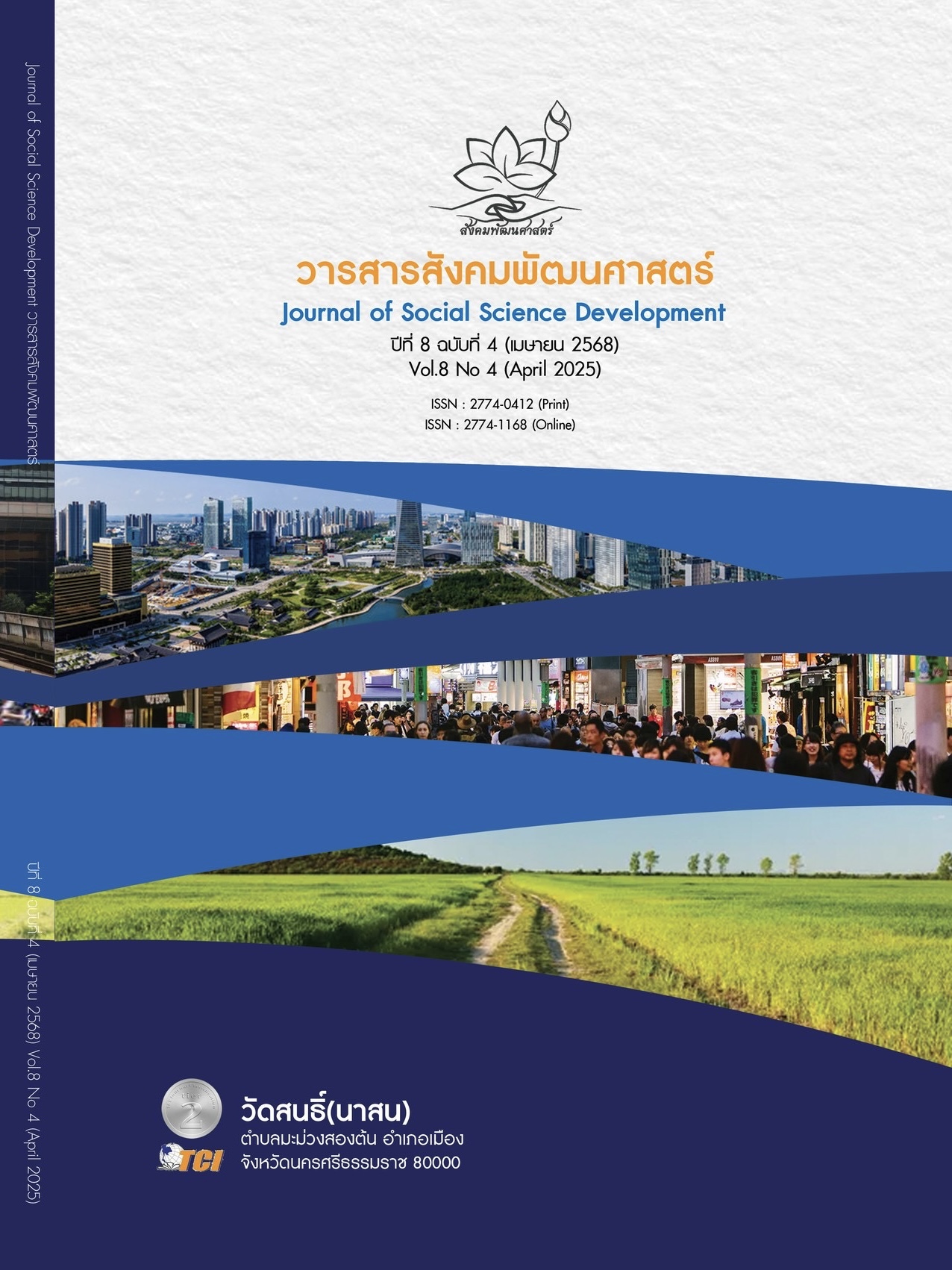THIPPHAYAPAYAN IN ADJUDICATION PROCEEDINGS: AN ANALYTICAL STUDY OF THE EVIDENCE ACT OF RATTANAKOSIN ERA 113
Main Article Content
Abstract
This article presents a legal analysis of the Evidence Act R.S. 113, a crucial law that established the principles of evidence in the traditional Siamese legal system. This Act classified witnesses into three types: Thippayayan, Udonpayan, and Uttaripayan. Thiphayapayan were individuals holding high positions within the royal court, noblemen, or those who were renowned and highly respected within the community. The credibility of a thiphayapayan was not invariably assessed based on factual information they had directly witnessed but rather stemmed from the confidence placed in their integrity, probity, and honor. However, with the influence of Western law, the Siamese legal system shifted, placing greater emphasis on empirical evidence than the qualities of the witness. The article aimed to study the role of Thippayayan under the Evidence Act R.S. 113 and analyze the changes in evidentiary concepts from the past to the present. Its article described the characteristics of Thippayayan and compared them with other witness types within the traditional legal framework. It further analyzed how their historical role reflected the concept of credibility and explained the current legal system's emphasis on physical evidence. Furthermore, it discussed the limitations of Thippayayan when considered as hearsay evidence, which often raises questions about the reliability of their testimony. The findings demonstrated that while Thippayayan held significant credibility historically, modern legal systems prioritize demonstrable facts over personal background in assessing witness reliability. This change reflects the evolution of evidentiary concepts and the judicial process towards greater fairness and accuracy. This knowledge can serve as a guideline for studying the history of Siamese evidence law and suggest methods for developing evidence law in line with international standards to balance empirical evidence with witness credibility in the Thai justice system.
Article Details

This work is licensed under a Creative Commons Attribution-NonCommercial-NoDerivatives 4.0 International License.
References
เข็มชัย ชุติวงศ์. (2565). คำอธิบายกฎหมายลักษณะพยาน. (พิมพ์ครั้งที่ 11). กรุงเทพมหานคร: สำนักพิมพ์วิญญูชน.
คณะกรรมการนักนิติศาสตร์สากล. (2551). ประเทศสยาม: ข้อสังเกตด้านกฎหมาย – พยานบอกเล่าและมาตรฐานสากลในการพิจารณาคดีอย่างเป็นธรรม. เรียกใช้เมื่อ 15 มีนาคม 2565 จาก https://www.icj.org/wp-content/uploads/2012/08/Thailand-hearsay-evidence-legal-submission-2008-tha.pdf
คนึง ฦาไชย. (2521). พยาน. ปทุมธานี: มหาวิทยาลัยธรรมศาสตร์.
คึกฤทธิ์ ปราโมช. (2518). ระบอบศักดินาสยาม. กรุงเทพมหานคร: สำนักพิมพ์สยามรัฐ.
ชยาธร เฉียบแหลม. (2563). การรับฟังพยานบอกเล่าในคดีอาญาระบบไต่สวน. วารสารนิติศาสตร์ มหาวิทยาลัยธรรมศาสตร์, 50(3), 281-313.
ธานี สิงหนาท. (2567). คำอธิบายพยานหลักฐาน คดีแพ่งและคดีอาญา. (พิมพ์ครั้งที่ 19). กรุงเทพมหานคร: สำนักพิมพ์วิญญูชน.
นัทมน คงเจริญ. (2558). การบังคับใช้สิทธิชุมชน: มองผ่านวัฒนธรรมทางกฎหมาย. CMU Journal of Law and Social Sciences, 8(1), 80-120.
__________. (2562). สรุปประเด็นคำบรรยาย วิชากฎหมายกับโลกสมัยใหม่ ชุดที่ 1. เรียกใช้เมื่อ 9 มีนาคม 2565 จาก http://www.law.cmu.ac.th/law2011/journal/e1556170398.pdf
บัญญัติ สุชีวะ. (2531). คำปราศรัยในพิธีปิดประชุมและอบรมผู้พิพากษามาศาลในภาค 9 ใน รายงานสรุปผลโครงการประชุมและอบรมเพื่อเพิ่มพูนประสิทธิภาพการทำงานของศาลในภาค 9 วันที่ 30-31 ม.ค. 2531 ณ อุทยานแห่งชาติทะเลบัน. สตูล: กรุงสยามการพิมพ์.
บุญญฤทธิ์ ตันอารีย์. (2559). การคัดค้านการรับฟังพยานหลักฐานที่ได้มาโดยมิชอบด้วยกฎหมาย: ศึกษาเปรียบเทียบกฎหมายเก่าและกฎหมายต่างประเทศ. ใน วิทยานิพนธ์นิติศาสตรมหาบัณฑิต สาขากฎหมายอาญา. มหาวิทยาลัยธรรมศาสตร์.
ประเสริฐ เสียงสุทธิวงศ์. (2567). คำถาม-คำตอบ ปัญหาข้อกฎหมาย วิธีพิจารณาความอาญาและพยาน หลักฐาน. นนทบุรี: ม.ป.พ.
พระยานิติศาสตร์ ไพศาล. (2502). คำสอนชั้นปริญญาตรี. พุทธศักราช 2501-2502 ประวัติศาสตร์กฎหมาย. ปทุมธานี: สำนักพิมพ์มหาวิทยาลัยธรรมศาสตร์.
พระราชบัญญัติลักษณะพยาน ร.ศ. 113. (2442). ราชกิจจานุเบกษา เล่มที่ 11 ตอนที่ 42 หน้า 400–438 (17 กุมภาพันธ์ 2442).
มานพ ถาวรวัฒน์สกุล. (2536). ขุนนางอยุธยา. ปทุมธานี: สํานักพิมพ์มหาวิทยาลัยธรรมศาสตร์.
ราชบัณฑิตยสถาน. (2550ก). กฎหมายตราสามดวง ฉบับราชบัณฑิตยสถาน เล่ม 2. กรุงเทพมหานคร: สำนักพิมพ์ราชบัณฑิตยสถาน.
__________. (2550ข). กฎหมายตราสามดวง ฉบับราชบัณฑิตยสถาน เล่ม 1. กรุงเทพมหานคร: สำนักพิมพ์ราชบัณฑิตยสถาน.
วิทิต บัวปรอท. (2564). ทิศ 6 ในพระพุทธศาสนากับการสร้างสัมพันธภาพระหว่างบุคคลในยุควิถีปกติใหม่. วารสารมหาจุฬานาครทรรศน์, 8(6), 214-215.
วินัย พงศ์ศรีเพียร. (2549). กฎหมายตราสามดวง: หน้าต่างสังคมสยาม. กรุงเทพมหานคร: สามลดาการพิมพ์.
ศรีศักร วัลลิโภดม และอภิวันทน์ อดุลพิเชฎฐ์. (2545). กฎหมายตราสามดวงกับความเชื่อของสยาม. กรุงเทพมหานคร: สำนักพิมพ์เมืองโบราณ.
สถาบันอนุญาโตตุลาการ. (2563). โครงการอบรมสำหรับผู้ที่จะปฏิบัติหน้าที่อนุญาโตตุลาการ ครั้งที่ 2/2563 หัวข้อ "การรับฟังและชั่งน้ำหนักพยานหลักฐาน". เรียกใช้เมื่อ 17 มีนาคม 2568 จาก https://tai.coj.go.th/th/calendar/category/detail/id/1/iid/1220
สัจจวัตน์ เรืองกาญจน์กุล. (2565). แนวคิดเกี่ยวกับกระบวนการยุติธรรมสยามสมัยโบราณ. วารสารนิติศาสตร์และสังคมท้องถิ่น, 6(1), 231-258.
สุชาติ เที่ยงธรรม. (2557). การพิสูจน์ในกระบวนการยุติธรรมสยาม (การศึกษากฎหมายการพิจารณาคดี). กรุงเทพมหานคร: สำนักพิมพ์จุฬาลงกรณ์มหาวิทยาลัย.
สุพิศาล ภักดีนฤบาล. (2556). 4 Dimensions การบริหารงานสืบสวน: กองบังคับการปราบปราม. นนทบุรี: บริษัท กรีนแอปเปิ้ล กราฟฟิคปริ้นติ้ง จํากัด.
หทัยกาญจน์ กำเนิดเพชร. (2565). การรับกฎหมายสมัยใหม่จากตะวันตก และการจัดทำประมวลกฎหมาย. เรียกใช้เมื่อ 10 มีนาคม 2565 จาก https://law.tsu.ac.th/detail.php?id_list=197&aNum=20240322114725
Barnabishvili, S. (2023). Comparative analysis of evidence law within the civil process: Comparative-legal research. Journal of Legal Studies, 32(46), 1–26.
Christie, C. J. (1996). A modern history of Southeast Asia: Decolonization, nationalism and separatism. London: I.B. Tauris.
Granot, M. et al. (2022). Scientific thinking about legal truth. Retrieved March 10, 2025, from https://pmc.ncbi.nlm.nih.gov/articles/PMC9298174/
Harding, A. & Pongsapan, M. (2021). Thai legal history: From traditional to modern law. United Kingdom: Cambridge University Press.
Harding, A. (2021). The use of hearsay in criminal proceedings: An updated framework. Asian Law Review, 33(4), 89–104.
Harvard Law Review. (2010). Admitting doubt: A new standard for scientific evidence. Harvard Law Review, 123(8), 2021–2043.
Smith, J. & Johnson, R. (2005). Buddhist law: Essays on the legal history of Thailand, Laos, and Burma. United Kingdom: Oxford University Press.
__________. (2023). Cultural expertise, law, and rights: A comprehensive guide. United Kingdom: Routledge.

